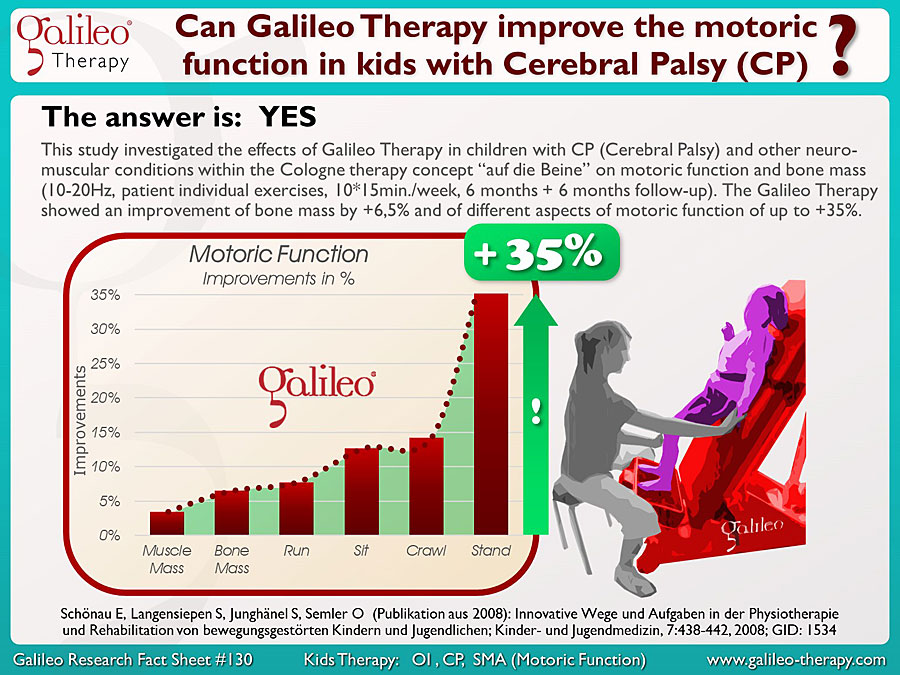This study investigated the effects of Galileo Therapy in Cerebral Palsy (CP, GMFCS 1&2, age 5-9) (Cologne Concept: 3x3 minutes, 10 session/week, 26 weeks) on walking distance (1MWT). Galileo Therapy showed a significant increase after 6 months (+17%) while there was no further increase in the following 6 months without Galileo but with individual standard therapy...
This study investigated effects of Galileo Therapy (3x3 min., 20Hz, pos. 2-3, 4/week, 20 weeks) in adolescents with Down Syndrome (age 10-19). The results after 20 weeks showed significant improvements in muscle function in endurance during 6MWT (distance: +12%) as well as movement efficiency (jump: +11%) or power in chair rise test (CRT, power: +15%, duration: -25%) and jump for maximum height (jumping height: +28%)...
This study investigated short-term effects of Galileo Therapy (16-25Hz, pos. 1,5-3, 1 min., 10° knee angle, fore-foot stance) in children with spastic Cerebral Palsy (CP, GMFCS 2-4, 4-12 Jahre). The results show a massive decrease in cocontraction (26% to 54%) and hence and increase in voluntary muscle activation (#GRFS165). Both effects explain are essential for reduction of Spasticity when using Galileo Therapy...
This study investigated short-term effects of Galileo Therapy (16-25Hz, pos. 1,5-3, 1 min., 10° knee angle, fore-foot stance) in children with spastic Cerebral Palsy (CP, GMFCS 2-4, 4-12 Jahre). The mechanical reflex (-12%), active Range of Motion (+15%) and the voluntary muscle activation (+17, +37%) was measured. The observed significant improvements explain why Galileo Therapy is so effective in Spasticity Management...
This study investigated the effects of Galileo Therapy in Cerebral Palsy (CP, GMFCS 1&2, age 5-10) (Cologne Concept: 3x3 minutes, 10 session/week, 26 weeks) on walking distance (6MWT). Galileo Therapy showed a significant increase in walking distance after 6 months (+17%) while there was no further increase in the following 6 months without Galileo but with individual standard therapy...
This study investigated the effects of Galileo Therapy in Spinal Muscle Atrophy (SMA, type II, III, IIIa, age 2-7) (Cologne Concept: 3x3 minutes, 10 session/week, 26 weeks). Galileo Therapy showed significant improvements in muscle function in Gross Motor Function Test (GMFM-66, +4%) and Hammersmith Functional Mobility Scale (HFMS, +9,5%). The following 6 months of standard therapy did not show further significant improvements...
This study shows the effect of Galileo Therapy (Cologne Concept: 3x3 minutes, 10 session/week, 26 weeks) in Ataxia patients (3-14 years, 2 groups: progressive and non-progressive). Both Galileo groups show significant improvements in GRMF66 (+7%), gait speed (+12%), 1MWT (+41%). In the following 6 months with standard therapy there was no additional relevant improvement in the parameters...
This study shows the effect of Galileo Therapy (Cologne Concept: 3x3 minutes, 10 session/week, 26 weeks) with Spina Bifida patients (5-13 years). Galileo Therapy not only decreased contractures in Hip and knee extension but also increased abilities in walking (+20%, GMFM-E) and standing (+36%, GMFM-D) as well as gait velocity by +50%...
This study investigated the effects of Galileo Therapy on the development of Scoliosis. The control group received Schroth-therapy (daily home-based + 2/week physiotherapy). The Galileo group only received Galileo Therapy (4 exercises, 4*3 min., 10-15Hz, 5/week, 6 months). Compared to the control group the Galileo group showed a significant decrease in the scoliosis extent (Cobb-angle) by up to 6% (2.5°)...
This study investigated the effects of Galileo Therapy in children with CP (Cerebral Palsy) and other neuro-muscular conditions within the Cologne therapy concept “auf die Beine” on motoric function and bone mass (10-20Hz, patient individual exercises, 10*15min./week, 6 months + 6 months follow-up). The Galileo Therapy showed an improvement of bone mass by +6,5% and of different aspects of motoric function of up to +35%...









